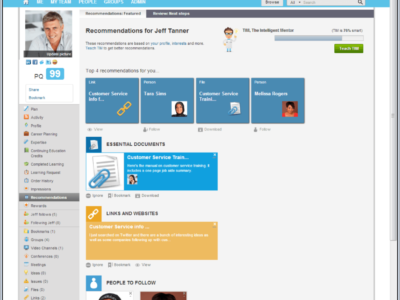

PeopleMatter – a talent management vendor focused only on the service industry, offers a streamlined and unremarkable LMS, is within the “Learn” component of their TM platform.Again, as previously listed, many large size vendors are turning into more a Human Capital Management system then a solo TM, heck even a LMS.With any trend, an upswing leads to newer approaches since competition always exists. Still a huge trend, and as previously noted in other posts, smaller size vendors are jumping into the arena. This new pipeline enables customers/clients of the vendors to have their LMS vendor as a one-stop shop, rather than going elsewhere or having themselves build the courses.To generate additional revenue, LMS vendors are adding custom course development (equally pitched as content development) as another offering.There were/are vendors who first and foremost have the LMS (primary), prior to adding a custom course development line – which is the trend we are talking about.Thus they give the illusion that all these clients are LMS clients, when the larger numbers tend to be as a result of custom content development – even still today As noted as “are”, some vendors still have a large client base, which is great, but will spin their marketing that these people are clients, without specifying of what -potential customers of their LMS, have no idea.There were/are vendors who entered the LMS market – this is to say, they first were a custom course development shop (primary product).While some never dropped to outsourcing, there is an increase in custom content/course development. LMS vendors are re-surfacing to offer in-house custom course development, as part of their offerings. Many vendors followed this approach, and the number of vendors who built in-house became a rarity (as a whole).

When you think about it, why have people in-house to build your own courses, when you can outsource the course building to either an individual, boutique or larger size course development shop (that has the experience, etc. However, there is a flip side to this – with sites like, odesk and elance, there are swaths of people willing to create on the cheap, thus pricing to build great courses are dropping, and occasionally quality follows suit (not all the time, mind you)īack in the early years you were more likely to see vendors build their own courses, with a nice size staff and someone who had an instructional design background leading the charge. Money – Depending on what you are offering, there are $$$ to be made.For the most part, it is one person, but I have seen groups of folks joining together to build content/courses Economy – with folks losing their jobs or unable to find work (due to layoffs, lack of hiring, among other things), more people are jumping into the instructional design, e-learning development and course creation.Reasons that the custom development market has exploded at a massive rate, just in the past year. In the early 2000s, there were plenty of custom development shops and costs ranged from 1K to 100K and more, but the custom development shops were not as plentiful as today. I know this one word is creating a stir among the instructor led crew and some educators, but in education we use the term “learning”, not “training” when we are teaching students. It can be seen in systems that dub themselves “training management” systems, HCMs that state “training” as a component, authoring tools that describe their product geared towards “training lessons or courses”, etc. We call online learning, e-learning, not e-training, but some vendors will have you believe that “training” is the appropriate term, rather than learning. This one trend really is an irritation to me, because the term “training” is showing up rather than “learning”, which is the standard term as it relates to online learning (see it already?). Twice a year I will be providing some trends that I am seeing in the e-learning market.


 0 kommentar(er)
0 kommentar(er)
